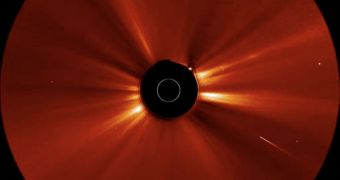For the second time in about 10 days, solar physicists discovered that a new comet had met a fiery end in the flames of the Sun. The event happened shortly after a massive solar eruption that took place on the star between May 20-21.
Until less than two weeks ago, no instances of such an event had been detected. Now, we have data on two comets that met their end at the same time a huge coronal mass ejection (CME) took place.
The latter event was observed by using the NASA STEREO (Solar TErrestrial RElations Observatory) spacecraft, which is dedicated to making observations of what goes on on the surface of the Sun.
It managed to discover that the impressive CME which took place a few days ago released a vast amount of charged particles in outer space. Fortunately, the emissions are not aimed at our planet.
Only one of the twin STEREO spacecraft was in a good position to capture the collision. It was able to see the entire event on video, but without the 3D capabilities that using this telescope usually enable.
“Soon after [the eruption], as a bonus visual, a sun-grazing comet came streaking in (from the right) heading for the Sun. Its tail could be seen elongating substantially as it approached the sun and apparently disintegrated,” NASA says in a statement released on May 27.
A similar event was discovered after a solar storm that took place on May 10-11. At that time, the SOHO solar observatory noticed that a comet had strayed too close to the Sun, causing it to fall towards the star's surface and get destroyed.
At around the same time the comet struck, the Sun released a strong CME. However, solar physicists say, there is currently no reason to believe that the two events are physically linked, or that they somehow determined each other, Space reports.
Both comets, experts add, are members of the Kreutz family, which means that they always stray very close to the surface of the Sun when they're visiting the inner solar system. Most of the times, they get within only a few hundred thousand miles from the star.
Astronomers find it very interesting that such events are spread so shortly after one another. Usually, the odds are stacked against such an event occurring very often. Yet, the same goes for cometary impacts on planets, and we saw several taking place on our gas giants over the past few years.

 14 DAY TRIAL //
14 DAY TRIAL //